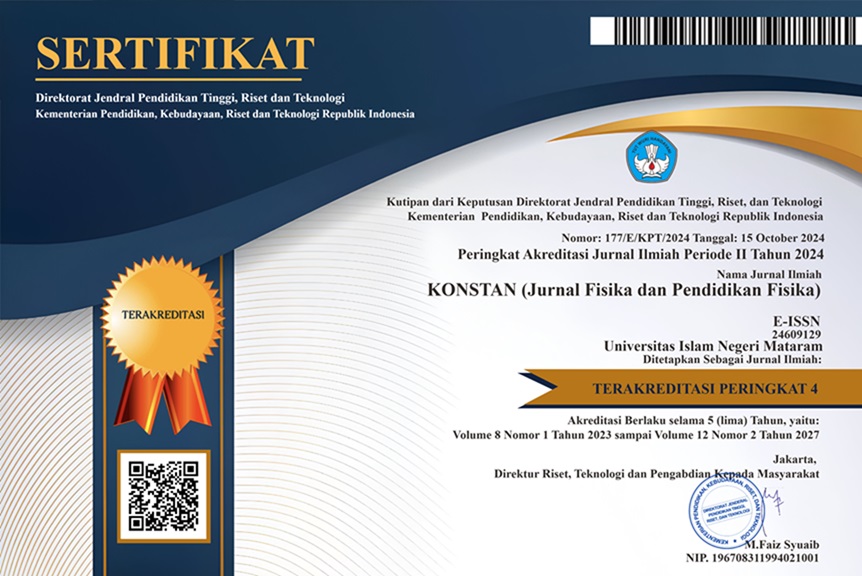Identification of Lightweight Concrete Characteristics Based on Density, Compressive Strength, and Absorbency Values with the Addition of Fly Ash and Glass Waste Aggregates
Abstract
Fly ash and glass waste can pose a significant environmental problem, as they cannot naturally decompose in the environment. This occurs due to the presence of pozzolan and silica in the waste. The purpose of this study is to categorize lightweight concrete and evaluate its properties, including density, compressive strength, and water absorption when incorporating additional fly ash and glass waste. This research uses experimental methods in the laboratory with a total of 72 samples with dimensions (25x25x50) mm in the form of blocks. Concrete samples were divided into two variations of storage duration, namely 21 days and 28 days, and given the same treatment and testing. The fly ash mixture variations used in this study were 0%, 20%, 40%, and 60%, with each variation consisting of 3 samples. The results obtained in this study indicate that, when viewed in terms of age, concrete with a storage period of 28 days exhibits better quality than concrete with a 21-day storage period. Based on the density value, both 21-day-old and 28-day-old concrete samples fall within the quality category of lightweight concrete, as per category A. When viewed from the compressive strength value, 21-day-old and 28-day-old concrete are of C quality. Regarding water absorption, the best value is achieved by the concrete mix with a 20% fly ash content and an 11% water absorption rate. When compared with concrete samples that do not contain fly ash, it is known that the test results on concrete samples without fly ash (0%) have higher compressive strength and density values, and the percentage of water absorption is by SNI standards.
Downloads
References
[2] Agusmal Dalimunthe, Siti Nurbaya, Natanael Priltius, and Pitalokasari br Ginting, "Analysis of calcium levels in duck egg (Anas platyrhynchos-domesticus) shell for making toothpaste with natural dye from pandan leaf (Pandanus amaryllifolius Roxb)," Farmanesia, vol. 9, no. 1, pp. 34–40, 2022, [Online]. Available: http://e-journal.sari mutiara.ac.id/index.php/2/article/view/3427
[3] Badan Standarisasi Nasional, “Sni 03-0691-1996,” Badan Standarisasi Nas., pp. 1–5, 1996.
[4] T. Mulyono, “TEKNOLOGI BETON: Dari Teori Ke Praktek,” 2018, pp. 1–26.
[5] W. A. Fistcar, “Implementasi Life Cycle Assessment (LCA) Pada Pemilihan Perkerasan Kaku dan Lentur Kontruksi Jalan Tol Balikpapan-Samarinda,” J. Apl. Tek. Sipil, vol. 18, no. 2, pp. 307–314, 2020, [Online]. Available: https://iptek.its.ac.id/index.php/jats
[6] G. Gunawan and Nono, "Potensi Pemanfaatan Bahan Limbah Fly Ash Dan Bottom Ash Untuk Lapisan Fondasi Jalan Semen (Potential for Utilization of Fly Ash and Bottom Ash Waste Materials for Cement Road Foundation)," J. Jalan-Jembatan, vol. 36, no. 1, pp. 19–29, 2019.
[7] S. Fahima, J. C. Tanjung, A. Sinatrya, I. R. Wulan, N. Ngadisih, and P. Lestari, “Kajian Dampak Penambangan Pasir Terhadap Kualitas Air Sungai Untuk Irigasi di Indonesia,” J. Teknol. Lingkung. Lahan Basah, vol. 12, no. 1, p. 284, 2024, doi: 10.26418/jtllb.v12i1.74581.
[8] M. W. K. E. S. S. Taufiq Lilo Adi Sucipto, “Pemanfaatan Limbah Kaca Sebagai Pengganti Sebagian Volume Pasir Dan Fly Ash 20% Sebagai Bahan Pengganti Semen Ditinjau Dari Kuat Tekan Dan Berat Jenis Beton Dalam Lingkungan Agresi Sulfat 5%,” Indones. J. Civ. Eng. Educ., vol. 6, no. 2, p. 24, 2020, doi: 10.20961/ijcee.v6i2.53664.
[9] A. Cahyadi, “Penggunaan Serbuk Kaca Dari Limbah Botol Kaca Sebagai Filler Agregat Halus Dalam Laston Lapis Antara (Ac-Bc) Asphalt,” STATIKA J. Tek. Sipil, vol. 8, no. 2, pp. 13–20, 2022, [Online]. Available: http://ejournal.polraf.ac.id/index.php/JTS/article/view/172%0Ahttps://ejournal.polraf.ac.id/index.php/JTS/article/download/172/213
[10] B. Nanda and S. Rout, "Properties of concrete containing fly ash and bottom ash mixture as fine aggregate," Int. J. Sustain. Eng., vol. 14, no. 4, pp. 809–819, 2021, doi: 10.1080/19397038.2021.1920641.
[11] R. I. Saputri, Y. C. V. Tethool, and R. O. Pramanagara, "Utilization of Waste Glass as Filler Material for Concrete Bricks," JISTECH J. Inf. Sci. Technol., vol. 12, no. 1, pp. 143–148, 2023, doi: 10.30862/jistech.v12i1.207.
[12] E. S. Sunarsih, G. W. Patanti, R. S. Agustin, and K. Rahmawati, "Utilization of Waste Glass and Fly Ash as a Replacement of Material Concrete," IOP Conf. Ser.. Earth Environ. Sci., vol. 1808, no. 1, 2021, doi: 10.1088/1742-6596/1808/1/012004.
[13] A. Steele, G. P. Wealthall, G. Harrold, N. Tait, S. A. Leharne, and D. N. Lerner, "Groundwater contamination by DNAPLs," Gr. Eng., vol. 32, no. 5, pp. 20–21, 1999.
[14] Badan Standarisasi Nasional, “SNI 03-0349-1989 Spesifikasi Bata beton untuk pasangan dinding,” Sni 03-0349-1989, no. 1, pp. 1–6, 1989.
[15] BSN, “Standarrisasi Nasional Indonesia 03 - 1973 - 2016 : Metode uji densitas, volume produksi campuran dan kadar udara (gravimetrik) beton,” 2016, [Online]. Available: www.bsn.go.id





